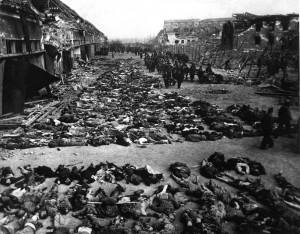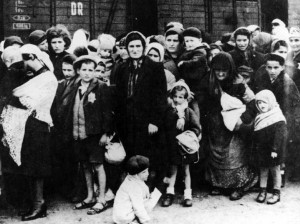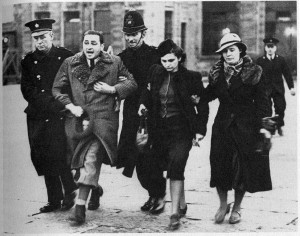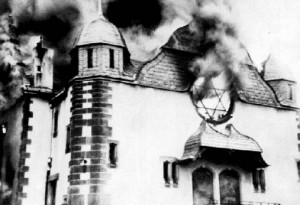Holocaust is a Greek word that means to sacrifice by fire. It comes from two words, “holos” which means whole, and “kautos” which means burned. It was a word historically used to describe a sacrifice that was made on the altar. In essence, the Holocaust was an organized, state-managed and bureaucratic killing of the Jews and other “undesirables” by the Nazi regime. During this era an approximated six million Jews, including German Jews, were prosecuted and murdered by the Nazi rule and its agents. The Nazis initially came to power to rule Germany in January 1933. They had a strong belief that the Germans were a superior race and that the Jews were an inferior race. Adolf Hitler deemed the Jews an alien threat to the German community.
During the Holocaust epoch, the German authorities targeted not only the Jews but also other groups of the society that were perceived to be inferior. This included the disabled, the Gypsies, Russians, Poles and others. They also persecuted people with different behavioral, ideological and political backgrounds such as the Jehovah’s Witnesses, socialists, homosexuals and the communists.
Pre-Holocaust
Anti-Semitism did not start with the reign of Adolf Hitler in Europe. It was long before he came to power that the use of the word came into existence in the 1870s. Hostility towards the Jews dates back to the ancient times when the Romans destroyed the Jewish temple and drove away all the Jews from Palestine. New enlightenment emphasized religious tolerance during the 17th and the 18th centuries. Then, in the 19th century, Europeans leaders being led by Napoleon enacted legislation which terminated the enduring restrictions on the Jewish religion. However, Anti-Semitic feeling still endured, but in this time it focused on discriminating against Jews based on their racial character rather than their religious views.
The reasons why Hitler was such a strong Anti-Semitist are still unclear, given that he was not a pure German. He was originally born in Austria in the year 1889 and grew up to serve in the Germany army during the World War I. However, just like all the other anti-Semites from Germany, he blamed the defeat of Germany in 1918 on the Jews. Soon after the end of World War I, Hitler became a member of the National Workers party. The group was soon renamed as the National Socialist German Worker’s Party and came to be popularly known among the English speakers as the Nazis. Hitler was soon imprisoned for treachery for playing part in the Beer Hall Putsch of 1923. While in prison he wrote a memoir and propaganda tract titled Mein Kampf (“My Struggle”) in which he predicted that there was going to be a major European war that will lead to the extinction of the Jewish race in Germany.
Hitler was obsessed with the superiority of the pure German race which he referred to as “Aryan.” He believed that pure Germans should expand their territory which could only be achieved through “lebensraum.” In his first decade after being released from the prison, Hitler benefited from the weaknesses of his rivals in enhancing the status of his party. On January 20, 1933, Hitler was named the new chancellor of Germany. One year later, after President Paul Hindenburg died, Hitler declared that he was the “Fuhrer,” becoming the supreme ruler of Germany.
The Revolution of the Nazi Regime
Hitler’s worldwide view had two main goals. This included spatial expansion and racial purity. From the year 1933, he combined the two goals to come up with a driving force that streamlined his domestic and foreign policy. Initially the Nazis gave the most severe persecution to political opponents, including the Social Democrats and the Communists. They opened their first concentration camp in Dachau, near Munich, in March 1933 where they imprisoned and murdered many communists. All the other concentration camps that were introduced later became the killing grounds of the Holocaust. Dachau was controlled by Heinrich Himmler who was the head of the elite Nazi guard.
By July of 1933, the German concentration camps, which are known as KZ or Konzentrationslager in Germany, had about 27,000 prisoners in custody. There were also large rallies held by the Nazis with symbolic acts such as the public burning of Jewish books which helped to pass on a message of how strong the Nazi party was. During this time, the population of Jews in Germany totaled to 525,000 which was only 1% of the entire population. This, however, did not deter the actions of the Nazis.
Over the next six years, the Nazis embarked on the “Aryanization” of the German race. They dismissed all the non-Aryans from the civil services, liquidated the businesses owned by the Jews and stripped the Jewish doctors and lawyers off their clients. Nuremberg laws of 1935 were enacted which stated that any person who had three or four Jewish grandparents was considered a Jew while a person with only two Jewish grandparents was a half-breed. Under these laws, the Jews became the routine targets for prosecution and stigmatization. This culminated in the Kristallancht, or “night of broken glass,” in November 1938. Here windows of the Jewish shops were destroyed and the synagogues in Germany were burned down. The occasion was marked by the killing of 100 Jews with thousands being arrested. From 1933 to 1936 hundreds of thousands of Jews who had the ability to leave Germany ran away while those who were left behind lived in a state of fear and uncertainty.
Beginning of the War
The Germany military occupied the western half of Poland in September of 1939. Soon the German police drove tens of thousands of the Jews in Poland to move from their homes to the ghettos. They also confiscated their property and gave them to the non-Jews outside of Germany who were acknowledged as Germans. The Jewish ghettos in Poland were surrounded by barbed wires and high walls. They therefore acted as the captive city-states where the Jews were held and governed by the Jewish councils. Life among the Jews became terrible. Apart from the widespread unemployment, hunger and poverty, the overpopulation in the ghettos made them breeding grounds for many diseases, with typhus topping up the list.
Towards the end of 1939, the Nazi officials chose about 70,000 Germans who were held in institutions for the mentally ill and the disabled to be gassed to death in an operation dubbed the Euthanasia program. Many prominent religious leaders in Germany consistently protested this move until Hitler decided to publicly stop the program in 1941. However, the killings of the disabled still continued in secrecy, and by 1945 the number of handicapped people that had been killed in the program totaled 275,000. This Euthanasia program became the pilot program for the Holocaust.
The Final Solution
Hitler’s empire expanded further during the summer and spring of 1940 which saw his army conquering France, Luxembourg, Belgium, Netherlands, Norway and Denmark. In the start of 1941, Jews from all over the European continent and thousands of Gypsies were taken to the Polish ghettos. Einsatzgruppen was introduced which comprised of mobile killing units which slaughtered more than 500,000 of the Jews from Russia and other regions.
On July 31, 1941, Hermann Goering, who was the top commander of Hitler, sent a memorandum titled Endlosung, or “the final solution,” to the chief of security service of the SS, Reinhard Heydrich. At the start of September, every person considered a Jew in the German-territories was marked with a yellow star, making them more noticeable targets. Many Jews were deported to the German occupied territories in USSR and the Polish Ghettos. At the same time experiments of mass killings were underway at the concentration camp of Auschwitz. In August, German officials sprayed 500 Soviet prisoners of war to death using the pesticide Zyklon-B.
The Death Camps of Holocaust
 Towards the end of 1941, there was mass transportation of the Jews from the Polish ghettos to the concentration camps. They began with the least useful people of the society; the old, the sick, the weak and the children. On March 17, 1942, the first mass gassing was done at the Belzec concentration camp. This resulted in the building of five more mass killing camps in Poland including Majdanek, Treblinka, Sobibor, Chelmno, and the largest, Auschwitz-Birkenau.
Towards the end of 1941, there was mass transportation of the Jews from the Polish ghettos to the concentration camps. They began with the least useful people of the society; the old, the sick, the weak and the children. On March 17, 1942, the first mass gassing was done at the Belzec concentration camp. This resulted in the building of five more mass killing camps in Poland including Majdanek, Treblinka, Sobibor, Chelmno, and the largest, Auschwitz-Birkenau.
The Nazis tried to keep the mass killings a secret, but the scale at which people died was too large to be ignored. In the largest concentration camp, Auschwitz, there were more than two million who died from the mass slaughter. In the summer of 1944, a large population of Jews from Hungary was transported to Auschwitz where more than 12,000 Jews were killed on a daily basis.
The End of Nazi Rule
During the spring of 1945, the leadership of Germany was dissolved following internal dissent. Both Himmler and Goering distanced themselves from Hitler in order to take power. Hitler made a last testament on April 29th where he urged the leaders of Germany to observe the strict rules of tribalism and show no mercy to the Jews. The next day he committed suicide. A week later, on May 8th, 1945, Germany surrendered from the war formally.
From the end of 1944 to the surrender of Germany in 1945, the forces of Germany had been evacuating thousands of Jews and sending the inmates to march towards the advancing front line of enemies. These were known as the “death marches” which led to the killings of about 375,000 people.
Impact of the Holocaust
The wounds of Holocaust, also known as “Shoah” in Hebrew, were slow to heal for everyone. Many of the people who survived the tragedy could not return home. In many cases, they had already lost all of their families and their neighbors had denounced their religion. In the late 1940s, the results were that the number of unprecedented refugees shot up and many prisoners of war moved across Europe looking for a place to stay. The allies of the Jewish held the Nuremberg trials to punish the criminals of the Holocaust. The allies also looked to create a homeland for the surviving Jews which led to the creation of Israel in 1948.
Over the years, many of the Germans fought with the bitter legacy of the Holocaust. The survivors of the nightmare sought compensation of the property and the wealth confiscated by the Nazi. In 1953, the government of Germany made payments to the Jewish people to acknowledge their responsibility in what the Nazi regime did. The government also agreed to take the responsibility of all the crimes committed during that time by the Nazis.


